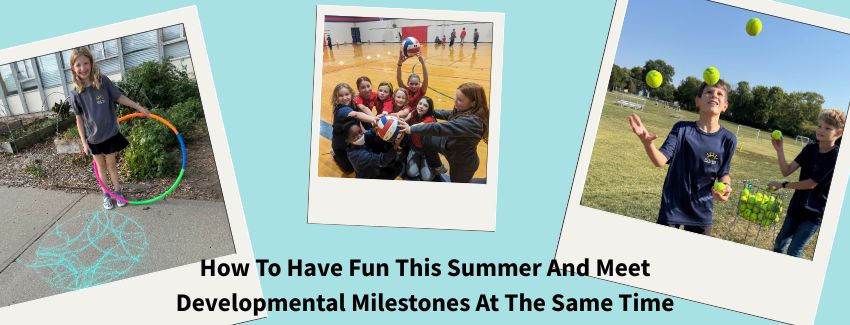Summer: How To Have Fun & Meet Developmental Milestones Too
May 29, 2025

Thoughts on summer break from an occupational therapist.
Summer is a great season to say yes to new interests, connect with the outdoors, and engage in enriching activities that naturally help children meet developmental milestones. In this blog post, we will examine activities and free play ideas for summer to boost independence, cultivate creativity, and let kids be kids! Many activities that happen organically outside (and off screens) help our children hone the skills that they need so they can grow and reach their potential.
How to have a joyous summer and meet your child's developmental milestones at the same time:
Parent Resources for Raising Independent Kids
The Anxious Generation and Let Grow are organizations that promote childhood independence and free play so that children can learn important life skills and build confidence. Screen Sanity is an organization based out of Kansas City that walks alongside parents to help them navigate raising children who are captivated by life, not by screens. These organizations have similar themes and may be helpful to you as you are supporting health and wellness for our child in today’s digital world. From the Occupational Therapy perspective, I encourage you to have your children try new activities, be outside in nature, experience different sensations, and practice social-emotional skills with their peers. Less structured summer days are great opportunities to have those experiences.
Summer Activities that Support Motor Milestones
Occupational Therapists help children (and adults, too) live life to the fullest. School-based OTs help children succeed in school by addressing motor milestones so they can reach their potential in educational activities. Below are activities for summer that can easily be incorporated into your children’s free time and help your child work on foundational milestones.
Sidewalk Chalk
Drawing on a sidewalk or driveway is a great way to encourage increased strength of the hands. When a child gets down on the ground to play with chalk, the core muscles are also engaged. Hopscotch is a fun way to incorporate gross motor and coordination skills. To incorporate neighborhood friends, invite others to complete a chalk obstacle course.
Mazes and Art with a Challenge
This year, many of my students loved mazes or pencil control challenges. This summer at home, add a challenge to a maze by taping it up on a vertical surface. Your child can complete a maze (or dot-to-dot or art project) while standing at a wall or easel for added proprioceptive input, shoulder strengthening, core engagement, and to facilitate wrist extension. Surprisingly, many inefficient grasps transition into a functional tripod grasp when a child writes on a vertical surface. At school, we stand on a Bosu Ball to incorporate balance while working on pencil control on a vertical surface. Another fun challenge is to have your child hide a cotton ball or penny in their palm with only their ring and pinky finger while grasping a pencil with their index, middle, and thumb. By doing this, they are working on the separation of the hand. The ulnar side (pinky side) of our hand is needed for stability, and our radial side (thumb side) is needed for precision. By tucking something into the ulnar side of our palm, we can refine this foundational skill.
Shoulder Stability Activities
When students have difficulty with handwriting, one of the first areas to assess is shoulder stability and upper body strength. Proximal stability (shoulder strength) is needed for distal mobility (hand movement). When proximal stability is not yet strong, students may compensate when writing by using a tight grasp, flexing or floating their wrist, or having an inefficient grasp pattern. In the summer, outside gross motor play like animal walks, rock or tree climbing, crawling through tunnels, and playing on playground equipment can help strengthen the muscles surrounding the shoulder. This year, my students have loved to use the roller racer scooter and zoom ball. Both activities are fun ways to increase upper-body strength. The shift from a play-based childhood to a screen-based childhood in today’s world has created a greater need to intentionally find activities for our children to participate in to address this motor milestone. The more we can incorporate free play and gross motor play, the more benefits our children will have in the school setting.
In Conclusion
As the Occupational Therapist at Horizon Academy, I support our students with meeting developmental milestones, overcoming sensory challenges, and improving self-care, play, and self-regulation skills. I am in the classrooms often and support our students within their educational setting, which provides an opportunity to collaborate with teachers regularly and help students apply and generalize their skills in a natural academic setting. We have had a great 2024-2025 school year, and I have witnessed unbelievable growth in Horizon Academy students. Our students work so hard, and I wish them an adventurous, restful, refreshing summer.
Megan Nicolas, Occupational Therapist at Horizon Academy
Additional Information
For More information about the organizations mentioned in this post, please visit:
https://www.anxiousgeneration.com/book
Horizon Academy empowers students diagnosed with dyslexia and other language-based learning disabilities to become effective learners and confident self-advocates. We are the only school west of the Mississippi River accredited by the Orton-Gillingham Academy. The Orton-Gillingham (O-G) Approach is the gold standard for teaching kids with dyslexia. Please visit our website for more information: www.horizon-academy.org
